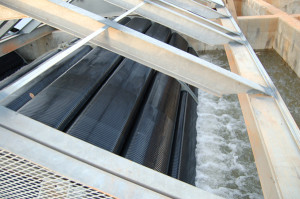 The heart of the wastewater treatment process is the Biorotor™ which consists of a rotating structure with patented cell plates arranged in a series of rows.
The heart of the wastewater treatment process is the Biorotor™ which consists of a rotating structure with patented cell plates arranged in a series of rows.
The cell plates are 3/4” apart and provide a roughened surface as media for fixed film growth, and also provide a source of aeration for the activated sludge. By adjusting the speed of rotation for varying oxygen requirements, treatment of the wastewater occurs both in the activated sludge and the fixed film.
During rotation of the Biorotor™, trapped air is gradually released into the mixed liquor as medium to fine bubble aeration. Some of the air is transferred from one pocket to another inside the cells providing additional buoyancy reducing energy requirements. Before the cells are rotated to the surface, a majority of the air is expended as medium/fine bubble diffusion. By this method, the time of retention of air-water contact is extended so that oxygen transfer is optimized.
The rotational speed of the Biorotor™ is adjustable, which regulates the amount of aeration and mixing in the bio-tank. The deep submergence of the wheel in the mixed liquor increases the efficiency of oxygen transfer.